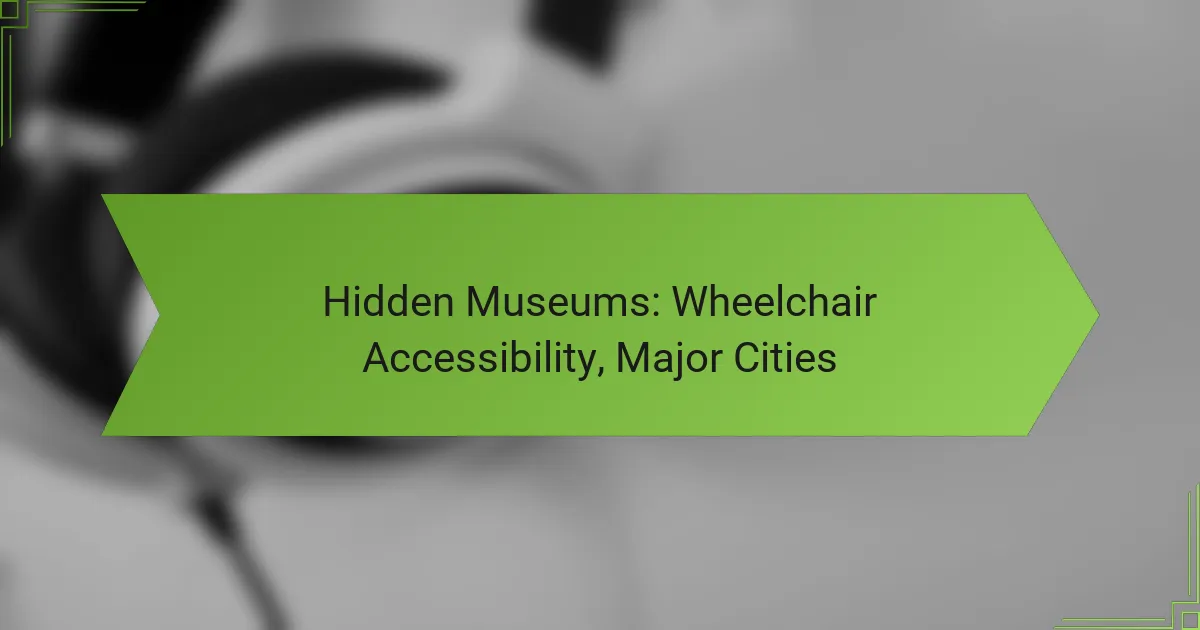Hidden museums often host free admission days, allowing visitors to discover unique collections of local art, history, and culture without any cost. These events not only enhance accessibility to cultural experiences but also promote community engagement and exploration of diverse exhibits.

What Are the Best Hidden Museums with Free Admission Days?
Many hidden museums offer free admission days, providing an excellent opportunity to explore unique collections without spending money. These museums often feature local art, history, and culture that may not be as widely recognized as larger institutions.
Smithsonian Institution
The Smithsonian Institution in Washington, D.C. is a collection of museums and research centers that offer free admission year-round. Visitors can explore diverse exhibits ranging from American history to natural sciences.
On select days, special events and programs enhance the experience, making it a great time to visit. Check the Smithsonian website for specific free admission days and any special programming that may be available.
Los Angeles County Museum of Art
The Los Angeles County Museum of Art (LACMA) provides free admission on certain days, typically on the second Tuesday of each month. This museum showcases a vast array of art from various cultures and time periods.
To make the most of your visit, arrive early to avoid crowds and consider joining a guided tour to gain deeper insights into the exhibits. Be sure to check their calendar for any changes to free admission policies.
Brooklyn Museum
The Brooklyn Museum offers free admission on the first Saturday of each month, allowing visitors to explore its extensive art collections and special exhibitions. This museum is known for its diverse range of artworks, including contemporary and ancient pieces.
During free admission days, the museum often hosts special events, performances, and family activities. Arriving early can help you secure a good spot for these events, as they can attract large crowds.
National Gallery of Art
The National Gallery of Art in Washington, D.C. is always free to enter, making it a fantastic destination for art lovers. The museum houses an impressive collection of European and American art, including works by masters like Van Gogh and Monet.
Visitors can take advantage of free guided tours and educational programs, which enhance the experience. Check their website for information on special exhibitions that may require timed entry tickets.
Chicago Museum of Science and Industry
The Chicago Museum of Science and Industry offers free admission on select days throughout the year, making it accessible for those interested in science and technology. This museum features interactive exhibits that engage visitors of all ages.
To maximize your visit, plan ahead by checking the museum’s calendar for free admission days and any special events. Arriving early can help you avoid long lines, especially during popular free days.

How Do Free Admission Days Benefit Visitors?
Free admission days offer significant advantages for visitors, making cultural experiences more accessible and enriching. These events not only reduce costs but also foster community connections and encourage exploration of diverse exhibits.
Cost savings for families
Free admission days provide substantial cost savings for families, allowing them to enjoy cultural outings without the financial burden. Families can save anywhere from $20 to $100, depending on the number of family members and the typical admission fees of the museum.
This financial relief enables families to allocate their budgets toward other activities, such as dining or transportation, enhancing the overall experience. Many families take advantage of these days to introduce children to art and history without worrying about ticket prices.
Access to exclusive exhibits
On free admission days, many museums showcase special exhibits that may not be available during regular hours. These exclusive displays often feature renowned artists or unique themes, attracting visitors eager to experience something new.
Participating in these events can provide insights into the latest trends in art and culture, as well as opportunities to engage with curators or experts. Visitors should check museum websites ahead of time for information on any special programming or guided tours available on these days.
Increased community engagement
Free admission days encourage greater community engagement by inviting diverse groups to participate in cultural activities. These events often attract individuals who may not typically visit museums, fostering a sense of belonging and shared experience.
Many museums use these days to host community events, workshops, or family-friendly activities, further enhancing interaction among visitors. Engaging with local artists or participating in hands-on activities can deepen connections to the community and its cultural heritage.
Encouragement of cultural exploration
Free admission days motivate visitors to explore new cultures and ideas, broadening their understanding of the world. By removing financial barriers, museums can inspire curiosity and appreciation for various art forms and historical narratives.
Visitors are encouraged to step outside their comfort zones and discover exhibits they might not have considered otherwise. This exploration can lead to a lifelong interest in the arts and humanities, enriching personal and community life.

What Are the Visitor Requirements for Free Admission Days?
Visitor requirements for free admission days at museums typically include advance reservations, age restrictions, and identification verification. These requirements ensure a smooth experience for all attendees while managing capacity and safety.
Advance reservations
Many museums require visitors to make advance reservations for free admission days. This helps manage crowd sizes and ensures that everyone has a spot. Reservations can often be made online, and it’s advisable to book as early as possible, especially for popular venues.
Some museums may limit the number of free tickets available per time slot, so checking their website for specific guidelines is essential. If you miss the reservation window, you may still be able to visit on a different day or during regular hours.
Age restrictions
Age restrictions for free admission days can vary by museum. Some institutions may offer free entry for all ages, while others might limit free admission to children under a certain age, such as 12 or 18. Adults accompanying minors may still need to pay a fee.
It’s important to verify the specific age policies of the museum you plan to visit, as these can affect your group’s overall cost and planning. Families should consider this when deciding on a visit during free admission days.
Identification requirements
Identification requirements for free admission days often include proof of age or residency. For example, children may need to show a birth certificate or student ID, while adults might be asked for a driver’s license or another form of ID to confirm their reservation.
Some museums may also require proof of eligibility for special programs, such as those for veterans or low-income visitors. Always check the museum’s website for detailed identification requirements to avoid any surprises on the day of your visit.

How Can Visitors Plan for Free Admission Days?
Visitors can effectively plan for free admission days by staying informed about museum schedules and policies. This involves checking official sources, signing up for updates, and following museums on social media to catch announcements and special events.
Check museum websites
Regularly visiting museum websites is crucial for finding accurate information about free admission days. Most museums list their admission policies, including specific dates for free entry, under their visitor information sections.
Look for dedicated pages or sections that outline upcoming events and promotions. Some museums may even offer a calendar view to easily identify free days.
Sign up for newsletters
Subscribing to museum newsletters is an effective way to receive timely updates about free admission days directly in your inbox. These newsletters often include exclusive offers, event notifications, and other visitor benefits.
Ensure you check your email preferences to receive relevant information without clutter. Many museums also offer incentives, such as early access to events, for newsletter subscribers.
Follow social media updates
Following museums on social media platforms like Facebook, Twitter, and Instagram can provide real-time updates on free admission days. Museums often post reminders and last-minute changes that may not be reflected on their websites.
Engagement on social media can also lead to special promotions or contests that offer additional benefits, making it a valuable tool for planning your visit.

What Are the Best Practices for Visiting Hidden Museums?
To make the most of your visit to hidden museums, consider strategies that enhance your experience while minimizing costs. Arriving early, using public transportation, and participating in guided tours can significantly improve your visit and help you discover unique exhibits.
Arrive early
Arriving early gives you a head start on exploring hidden museums before crowds arrive. This allows for a more intimate experience with the exhibits and often provides better opportunities for photography without interruptions.
Many hidden museums have limited hours or special free admission days, so check their schedules in advance. Aim to arrive at least 30 minutes before opening to secure your spot and enjoy a quieter atmosphere.
Use public transportation
Using public transportation is a practical way to reach hidden museums, especially in urban areas where parking can be limited and expensive. Buses, trams, or subways often drop you off close to museum entrances, saving time and money.
Research local transit options and consider purchasing a day pass if you plan to visit multiple sites. This not only reduces your carbon footprint but also allows you to enjoy the local scenery during your travels.
Participate in guided tours
Participating in guided tours can enhance your understanding of the exhibits and the museum’s history. Knowledgeable guides often share insights and stories that you might miss when exploring on your own.
Check if the museum offers free or discounted guided tours on specific days. These tours can provide a richer context for the artifacts and help you appreciate the hidden gems within the museum.

What Are the Unique Features of Hidden Museums?
Hidden museums often offer distinctive characteristics that set them apart from traditional institutions. These venues may feature specialized collections, unique themes, or unconventional locations, providing visitors with an intimate and often less crowded experience.
Free Admission Days
Many hidden museums host free admission days, allowing visitors to explore without the financial barrier. These days can vary by location and may occur monthly or quarterly, so checking the museum’s website or social media for announcements is advisable.
On free admission days, it’s common for museums to offer guided tours or special events that enhance the visitor experience. Arriving early can help you avoid long lines and ensure you make the most of your visit.
Visitor Benefits
Visiting hidden museums can provide numerous benefits, including access to unique exhibits and a more personal interaction with staff. These museums often emphasize community engagement, offering workshops and talks that deepen the understanding of their collections.
Additionally, hidden museums may have fewer crowds, allowing for a more relaxed atmosphere. This can lead to a richer experience, as visitors have the opportunity to engage more deeply with the art and artifacts on display.



